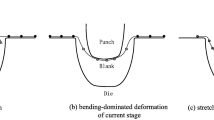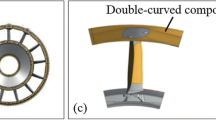Abstract
The aim of this study is to develop a reduced single-pattern model for a multi-pattern metal forming process called repetitive corrugation and straightening (RCS) which belongs to the category of Severe Plastic Deformation (SPD) processes. The corrugation die in RCS is composed of multiple similarly repeated patterns. First, a full multi-pattern model with a large number of patterns is developed. An analysis of this model reveals that the mechanical fields stabilize in the patterns away from the free boundary. Then, a reduced model defining a single pattern is developed to represent the stabilized behavior of the multi-pattern model, based on an approximate description of the boundary conditions in the stabilized sections of the multi-pattern model. Three different boundary conditions are proposed to capture the stress redistribution after each stage of the process in the reduced single-pattern model. It is shown that the single-pattern model with a symmetric-periodic boundary condition during unloading is the best choice to reproduce the stress and strain behavior of the stabilized sections of the multi-pattern model.















Similar content being viewed by others
Notes
Only the right half of each pattern are investigated due to the fact that the stress and strain values in each pattern are almost symmetric because of the the symmetric form of corrugation die patterns.
References
Ammar A (2010) The proper generalized decomposition: a powerful tool for model reduction. Int J Mater Form 3:89–102
Azushima A, Kopp R, Korhonen A, Yang DY, Micari F, Lahoti GD, Groche P, Yanagimoto J, Tsuji N, Rosochowski A, Yanagida A (2008) Severe plastic deformation (SPD) processes for metals. CIRP Ann 57:716–735
Ben Moussa N, Sidhom H, Braham C (2012) Numerical and experimental analysis of residual stress and plastic strain distributions in machined stainless steel. Int J Mech Sci 64:82–93
Bhovi PM, Gururaj SH, Lohit RB, Venkateswarlu K (2018) Simulation studies on RCS processed Al-Mg-Sc alloy. Mater Today Proc 5:7525–7531
Bhovi PM, Patil DC, Kori SA, Venkateswarlu K, Huang Y, Langdon TG (2016) A comparison of repetitive corrugation and straightening and high-pressure torsion using an Al-Mg-Sc alloy. J Mater Res Technol 5:353–359
Cao TS (2017) Models for ductile damage and fracture prediction in cold bulk metal forming processes: a review. Int J Mater Form 10:139–171
Chinesta F, Ladeveze P, Cueto E (2011) A short review on model order reduction based on proper generalized decomposition. Arch Comput Methods Eng 18:395–404
Elizalde S, Ezequiel M, Figueroa IA, Cabrera JM, Braham C, Gonzalez G (2020) microstructural evolution and mechanical behavior of an Al-6061 alloy processed by repetitive corrugation and straightening. Metals 10:489
Ezequiel M, Figueroa IA, Elizalde S, Cabrera JM, Braham C, Morin L, Gonzalez G (2020) Numerical and experimental study of a 5754-aluminum alloy processed by heterogeneous repetitive corrugation and straightening. J Mater Res Technol 9:1941– 1947
Gorji MB, Mohr D (2018) Predicting shear fracture of aluminum 6016-T4 during deep drawing: Combining Yld-2000 plasticity with Hosford–Coulomb fracture model. Int J Mech Sci 137:105–120
Hadoush A, van den Boogaard A (2008) Time reduction in implicit single point incremental sheet forming simulation by refinement - derefinement. Int J Mater Form 1:1167–1170
Hajizadeh K, Ejtemaei S, Eghbali B (2017) Microstructure, hardness homogeneity, and tensile properties of 1050 aluminum processed by constrained groove pressing. Appl Phys A 123 :504
Huang JY, Zhu YT, Jiang H, Lowe TC (2001) Microstructures and dislocation configurations in nanostructured Cu processed by repetitive corrugation and straightening. Acta Mater 49:1497–1505
Huang Y, Langdon TG (2013) Advances in ultrafine-grained materials. Mater Today 16:85–93
Huttunen-Saarivirta E, Kilpi L, Hakala TJ, Metsäjoki J, Ronkainen H (2018) Insights into the behaviour of tool steel-aluminium alloy tribopair at different temperatures. Tribol Int 119:567–584
Inoue T, Tsuji N (2009) Quantification of strain in accumulative roll-bonding under unlubricated condition by finite element analysis. Comput Mater Sci 46:261–266
Jenix Rino J, Balasivanandha Prabu S, Padmanabhan KA (2018) On the influence of repetitive corrugation and straightening on the microstructure and mechanical properties of AA 8090 Al-Li alloy. Arch Civil Mech Eng 18:280–290
Kawasaki M, Horita Z, Langdon TG (2009) Microstructural evolution in high purity aluminum processed by ECAP. Mater Sci Eng A 524:143–150
Kerfriden P, Passieux JC, Bordas SPA (2012) Local/global model order reduction strategy for the simulation of quasi-brittle fracture. Int J Numer Methods Eng 89:154–179
Lee BH, Keum YT, Wagoner RH (2002) Modeling of the friction caused by lubrication and surface roughness in sheet metal forming. J Mater Process Technol 130-131:60–63
Morin L, Braham C, Tajdary P, Seddik R, Gonzalez G (2021) Reconstruction of heterogeneous surface residual-stresses in metallic materials from X-ray diffraction measurements. Mech Mater 158:103882
Morin L, Leblond JB, Tvergaard V (2016) Application of a model of plastic porous materials including void shape effects to the prediction of ductile failure under shear-dominated loadings. J Mech Phys Solids 94:148–166
Niroomandi S, Alfaro I, Cueto E, Chinesta F (2008) Real-time deformable models of non-linear tissues by model reduction techniques. Comput Methods Programs Biomed 91:223– 231
Nor FM, Osman N, Kurniawan D (2020) Finite element analysis of repetitive corrugation and straightening die designs for severe plastic deformation of magnesium alloy. AIP Conf Proc 2262:030017
Paux J, Ben Bettaieb M, Badreddine H, Abed-Meraim F, Labergere C, Saanouni K (2020) An elasto-plastic self-consistent model for damaged polycrystalline materials: Theoretical formulation and numerical implementation. Comput Methods Appl Mech Eng 368:113138
Rahimi F, Sadeghi BM, Ahmadi M (2018) Finite element analysis of the deformation behaviour of pure aluminium in repetitive corrugation-straightening and constrained groove pressing. Int J Manuf Technol Manag 32:598–609
Ryckelynck D, Chinesta F, Cueto E, Ammar A (2006) On the a priori model reduction: Overview and recent developments. Arch Comput Methods Eng 13:91–128
Shin DH, Park JJ, Kim YS, Park KT (2002) Constrained groove pressing and its application to grain refinement of aluminum. Mat Sci Eng A 328:98–103
Shirdel A, Khajeh A, Moshksar MM (2010) Experimental and finite element investigation of semi-constrained groove pressing process. Mater Des 31:946–950
Thangapandian N, Balasivanandha Prabu S, Padmanabhan KA (2016) Effects of die profile on grain refinement in Al–Mg alloy processed by repetitive corrugation and straightening. Mater Sci Eng A 649:229–238
Torkestani A, Dashtbayazi MR (2018) A new method for severe plastic deformation of the copper sheets. Mat Sci Eng A 737:236–244
Valiev RZ, Islamgaliev RK, Alexandrov IV (2000) Bulk nanostructured materials from severe plastic deformation. Prog Mater Sci 45:103–189
Westlund V, Heinrichs J, Jacobson S (2018) On the Role of Material Transfer in Friction Between Metals : Initial Phenomena and Effects of Roughness and Boundary Lubrication in Sliding Between Aluminium and Tool Steels. Tribology Letters 66
Xiao X, Tong X, Liu Y, Zhao R, Gao G, Li Y (2018) Prediction of shot peen forming effects with single and repeated impacts. Int J Mech Sci 137:182–194
Acknowledgements
Fruitful discussions with P. Gilormini are gratefully acknowledged. G. Gonzalez acknowledges the funding support from UNAM-DGAPA-PAPIIT through project IN102321.
Author information
Authors and Affiliations
Corresponding author
Ethics declarations
Conflict of Interests
The authors declare that they have no conflict of interest.
Additional information
Publisher’s note
Springer Nature remains neutral with regard to jurisdictional claims in published maps and institutional affiliations.
Rights and permissions
About this article
Cite this article
Tajdary, P., Morin, L., Braham, C. et al. A reduced single-pattern model for the numerical simulation of multi-pattern metal forming. Int J Mater Form 14, 1403–1416 (2021). https://doi.org/10.1007/s12289-021-01636-6
Received:
Accepted:
Published:
Issue Date:
DOI: https://doi.org/10.1007/s12289-021-01636-6




